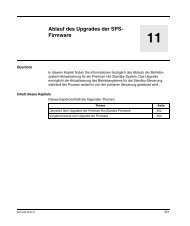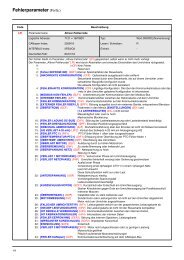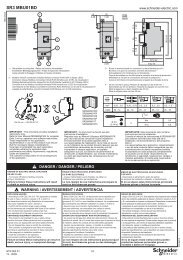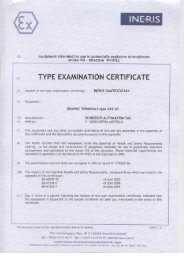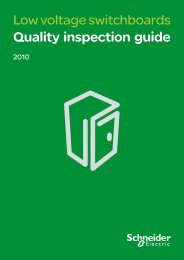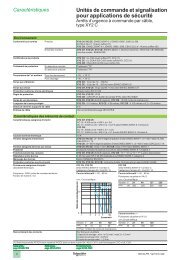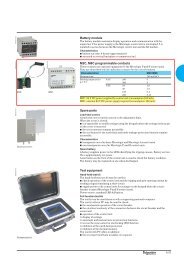Nu-Lec Training Modules PTCC Controller - Schneider Electric
Nu-Lec Training Modules PTCC Controller - Schneider Electric
Nu-Lec Training Modules PTCC Controller - Schneider Electric
Create successful ePaper yourself
Turn your PDF publications into a flip-book with our unique Google optimized e-Paper software.
Technician <strong>Training</strong><strong>PTCC</strong> Hardware <strong>Modules</strong>Switchgear ServiceProceduresCAPM Power SupplyA brief description of the hardware modules in a recloser installation and how they connect together.Basic fault finding on reclosers and load break switches using <strong>PTCC</strong> controllers.Explains the function of the batteries and the auxiliary supply options.Automation<strong>PTCC</strong> Automation OverviewAutomatic Protection GroupSelectionGenerator ControlAutomatic-ChangeoverLoop AutomationAn introduction to the automation features that can be used with switchgear and <strong>PTCC</strong> controllers.How to configure the controller to change protection groups automatically when the power flowdirection changes.How an ACR can be used in conjunction with a standby generator.How ACR’s can be used in an automatic changeover scheme.How ACR’s can be used in a scheme to maintain supply to healthy sections of a network whenfaulty sections have been isolated by protection devices.Page 2 of 9
Protection/Detection<strong>PTCC</strong> Basic ProtectionElements<strong>PTCC</strong> Inverse Time CurveProtectionAdditional ProtectionElements for the <strong>PTCC</strong>Under_Over VoltageProtection<strong>PTCC</strong> Protection FeaturesLBS Fault DetectionLBS SectionalisingCovers the basic protection elements, global protection settings and operator settings.Explains the options available for protection discrimination using Definite Time, Instantaneous Onlyand Inverse Time Curve settings.Other protection options that are available on the <strong>PTCC</strong> such as Negative Phase Sequence,Under/Over frequency and Loss of Phase protection.How Under and Over Voltage Protection is implemented on the <strong>PTCC</strong> controller.Explains protection features such as, Cold Load Pickup, Inrush Restraint and High Current Lockout.How fault detection is achieved on the RL Series load break switch.Using the RL load break switch as a sectionaliser.Communications and ProtocolsIntroduction to SCADAMODBUS ProtocolDNP3 Implementation for<strong>Nu</strong>-<strong>Lec</strong> ReclosersIEC 60870-5-101MITS ProtocolImplementation<strong>PTCC</strong> RS-232 Commm PortsSetupAn introduction to SCADA systems used by electricity utilities.An introduction to communications protocols and MODBUS in particular as it is used withswitchgear using <strong>PTCC</strong> controllers.A description of <strong>Nu</strong>-<strong>Lec</strong>’s implementation of the DNP3 communications protocol.A description of <strong>Nu</strong>-<strong>Lec</strong>’s implementation of the IEC 60870-5-101 communications protocol.The fundamentals of the MITS Limited ‘Megadata’ telemetry protocol and how it is implementedfor <strong>Nu</strong>-<strong>Lec</strong> reclosers.How to configure the RS-232 communications ports on a CAPM controller.Page 3 of 9
WSOS4 Features and ToolsWSOS – An OverviewWSOS – User GuideWSOS FeaturesWSOS Comms OverviewUser Defined CurvesAutomatic Data RetrievalConfigurable IOEXConfigurable DNP3Monitoring SystemWSOS Landline and GSMCommunicationsAn introduction to the Windows Switchgear Operating System used with <strong>Nu</strong>-<strong>Lec</strong> switchgear andcontrollers.Getting started using WSOS to configure switchgear and manage files.An introduction to WSOS features such as User Defined Curves, Automatic Data Retrieval andConfigurable IOEX.An overview of communications options used with WSOS.How customised protection curves can be created in WSOS and transferred to the <strong>PTCC</strong> controller.An automated system for remotely downloading history files from switchgear with <strong>PTCC</strong>controllers.Configuring the inputs and outputs on an Input Output Expander module using WSOS.Configuring the mapping for the DNP3 communications protocol in a <strong>PTCC</strong> controller.Using WSOS as a change of state monitoring system with remotely controlled switchgear.How WSOS can communicate with switchgear controllers using landline and GSM communicationssystems.Page 4 of 9
SwitchgearApplicationsRecloser Application NotesRL27 ApplicationsA discussion on the applications for automatic circuit reclosers.How sectionalising occurs to isolate faults on a medium voltage electrical network.N Series ACRN Series OverviewN Series Product OperationN Series Components andOperationN Series ACR InstallationA brief description of the physical features of the N Series automatic circuit recloser.How the N Series ACR operates.A look inside the N Series ACR and how opening and closing takes place.How to install an N Series ACR.U Series ACRU Series OverviewU Series Product OperationA brief description of the physical features of the U Series automatic circuit recloser.How the U Series ACR operates.Page 5 of 9
W Series ACRW Series OverviewW Series Product OperationA brief description of the physical features of the W Series automatic circuit recloserHow the W Series ACR operates.RL Series LBSRL Series OverviewRL Series Product OperationA brief description of the physical features of the RL Series load break switch.How the RL Series LBS operates.Switchgear GeneralACR/LBS General FeaturesEarthing the recloserAn overview of the general features of the <strong>Nu</strong>-<strong>Lec</strong> range of reclosers and load break switches.Earthing requirements for reclosers and controllers.Page 6 of 9
Advanced <strong>Controller</strong>Construction and <strong>Modules</strong>ADVC – The BasicsAn introduction to the physical construction and modules that make up the ADVC.Basic Operator FunctionsBasic Operator FunctionsThe purpose of this module is to give trainees a feel for navigating the operator control panel.SpecificationsADVC vs <strong>PTCC</strong>This module explains the general specifications of the ADVC and how they compare with the<strong>PTCC</strong>.InstallationADVC Mounting, Earthingand ConnectionsADVC Testing andCommissioningChecking the ADVCInstallationThis module explains the mounting and earthing requirements of the ADVC as well as the method ofconnecting external cable and wiring.An explanation of the options available for testing and commissioning an ADVC.A description of the steps that should be taken to ensure that an ADVC has been installed correctly.Page 7 of 9
MaintenanceADVC Module ReplacementADVC Power Supply andBattery ManagementADVC Battery TestADVC CommunicationsDiagnosticsWaveform GenerationHow to remove and/or replace the individual modules that make up and ADVC.An explanation of how the auxiliary power supply and battery management is handled in the ADVC.How the Battery Test function operates in the ADVC and how it can be configured for manual orautomatic operation.Explains how the various mode of operation can be used to capture the communication trace forADVC SCADA operation.How the Waveform Generation feature can be used to simulate current and voltage injection in theADVC.Advanced Operator FunctionsUsing the ADVC Event LogUnderstanding the ADVCMeasurement SystemConfiguring the ADVCCommunications Ports.ADVC CustomisationPower Quality Tool KitHow to navigate and interpret the event log and apply features such as displaying the source ofevents and applying filters.Understanding instantaneous and demand data displayed in the Measurement menu and configuringthe demand period.How to enable and configure the required communications ports and protocol settings.An explanation of the various customisation features available for the ADVC such as customisedmenu and feature selection.How to configure and use power quality features such as Harmonic Analysis and WaveformCapture.Page 8 of 9
ProtectionADVC Basic ProtectionElementsADVC ProtectionDiscriminationAdditional ProtectionElementsUnder and Over VoltageProtectionProtection FeaturesDirectional ProtectionA description of basic protection elements, global protection settings, reset curves and operatorsettings.This module explains how discrimination is achieved in the ADVC using time, current and inversecurves.A description of the additional protection elements such as Negative Phase Sequence andUnder/Over Frequency protection.How under and over voltage protection is implemented in the ADVC.This module covers some of the features that are protection related such as Sequence Control, InrushRestraint and Cold Load Pickup.An explanation of how the ADVC uses directional protection to respond to faults that occur oneither side of the switchgear.CommunicationsDNP3 Implementation for theADVCA detailed description of how the DNP3 communications protocol is implemented on the ADVC.WSOS5WSOS5 – The BasicsWSOS5 – What’s NewConfigurable DNP3 for theADVCAn introduction to the basic functions of WSOS5An overview of some of the new features of WSOS5How the DNP3 communications protocol can be configured for the ADVC using the WSOS5Configurable Protocol Tool.Page 9 of 9



